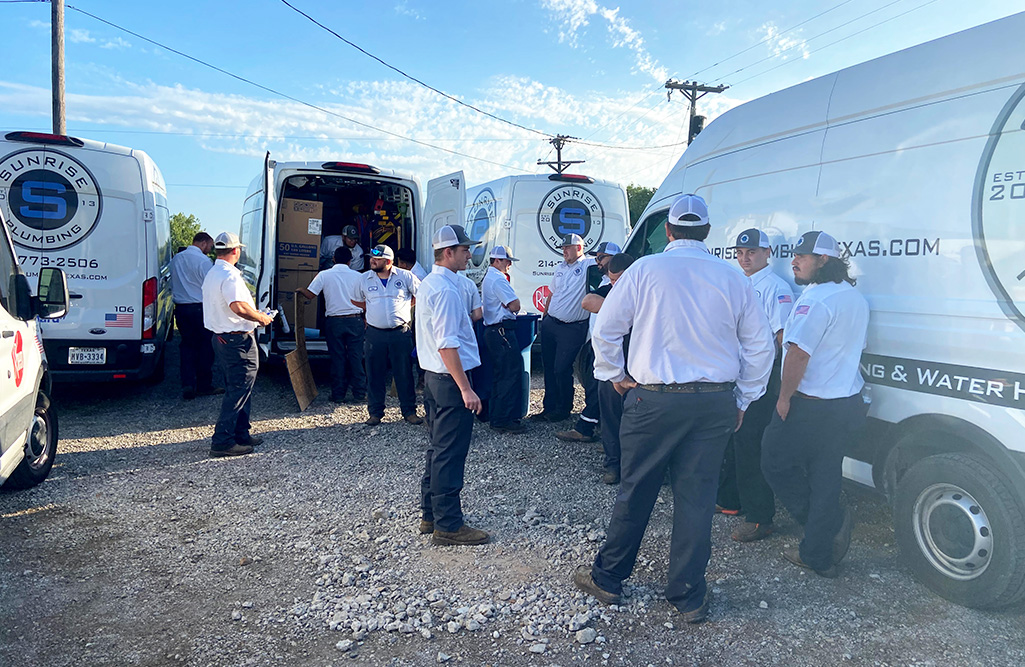
Plumbing Services in Rockwall
Plumbing issues in your home can be more than just a bother—they can upset your daily routine and disturb your peace of mind. That's where Sunrise Plumbing steps in. Our team offers a comprehensive range of plumbing services, covering everything from basic repairs to total system replacements.
We offer a comprehensive range of plumbing solutions, including:
- Drain and sewer services
- Water heater repair and replacement
- Leak detection for slab leaks
- Emergency plumbing services
- Plumbing fixture services
- Garbage disposal services
- Gas leak services
- Water treatment services
- Toilet services
- Tankless water heater services
- Piping and repiping services
- Leaking pipes services
- Slab leak services
We operate according to the principles of prompt action and treat your plumbing issues with urgency. Preserving your peace of mind is our top priority, and we work diligently to uphold the comfort and efficiency of your living space with as little disruption to your daily routine as possible.
Call (214) 773-2506 today and discover why we're the trusted choice for plumbing excellence in Rockwall, TX.
When to Call Our Team
Recognizing when to call a plumber can be challenging if you are not familiar with plumbing systems. There are, however, specific signs that you should keep an eye out for, as they could point to issues that require professional attention.
Here are some common signs indicating it's time to have your plumbing inspected by a member of our team:
- Persistent dripping or leaking faucets
- Low water pressure
- Slow-draining sinks or tubs.
- Gurgling sounds from drains or toilets
- No hot water
- Water spots on walls or ceilings
- Unpleasant odors
If you notice any of these symptoms, it's crucial to act quickly to prevent further damage.
Should I Try to DIY?
When it comes to home plumbing, the question of whether to DIY or call in a professional is a common conundrum for homeowners. While taking on minor repairs yourself, such as replacing a washer in a leaky faucet, can save you money, it's important to understand your limits.
More complex issues like major leaks, installing new pipes, or dealing with sewer problems require a depth of knowledge, experience, and specialized tools that most DIY enthusiasts don't have access to.
It is also important to mention that making one small mistake can lead to costly damage and potentially dangerous situations.
To ensure your safety and the stability of your plumbing system, we recommend you play it safe and call our team when you are experiencing an issue, big or small.
Experience "The New Standard" of Excellence
-
Professionally TrainedTop industry professionals. Background-checked, drug-tested, and highly-trained.
-
Service FirstOn-time and courteous. Always in uniforms and shoe covers. As professionals we arrive when promised and work with a service-first mentality.
-
100% Satisfaction GuaranteeGoing above and beyond. We do more than just get the job done, and we do everything 100% with your needs in mind.
-
Fully Transparent PricingStraightForward Pricing® with ZERO hidden charges. Know what you’re paying for before any work is done.


Happy Customers in Your Neighborhood
At Sunrise Plumbing, your satisfaction is our priority! See for yourself what our customers have to say about working with us.
-
“Very professional, friendly, knowledgeable, and does excellent work, with excellent workmanship and work ethics. I had a gas leak, he found the leaks and replaced the gas pipe and repaired all the leaks in the attic too.”- James K.
-
“Fantastic experience!! Called for a busted pipe issue and technician was on site with in the hour. Jeff was super friendly and knowledgeable!”- Billie L.
-
“Andrew and Nick replaced our water heater in record time. They did an amazing job! I’m a big fan of Sunrise Plumbing. Thank you for taking such good care of my family.”- Brad H.
-
“He made me feel comfortable in understanding the process and what steps needed to be completed in order to fix our main water line leak. I would highly recommend Zane for any service needs/repairs.”- Kristen M.
-
“Andrew was very pleasant to work with. Very professional and courteous and knowledgeable. His company will become our go to for all plumbing work from now on because of the first great impression today.”- Frank G.
-
“He is a consummate professional and happily explained the details of the work and is a credit to Sunrise. I commend Sunrise and Andrew in particular to any and all from their service area.”- Satisfied Customer

Did you Know? The plumbing system is the largest operating part of your home? Preventive maintenance for your plumbing system is critical to obtaining the proper health of your biggest investment, which is your home.